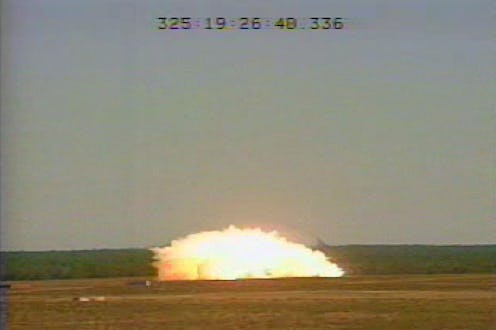News
Where The "Mother Of All Bombs" Name Came From

On Thursday, the United States dropped the largest non-nuclear bomb in its history on an Islamic State cave complex in Afghanistan. The bomb, known as a GBU-43/B Massive Ordnance Air Blast (MOAB), is 30 feet long, weighs 21,000 lb., and is guided by GPS. Lots of discussion has surrounded the bombing, but you may be wondering where the nickname "Mother of All Bombs" comes from.
The name is reportedly a reference to Saddam Hussein, who claimed that the 1991 Gulf War would be the "mother of all battles." According to Business Insider, the phrase "mother of all battles" has origins in the Quran, where it describes Mecca as the "mother of all settlements" or "mother of all cities." Basically, it is used when someone wants to describe something as the most important or highest example of a certain category. So in this case, the most powerful non-nuclear bomb.
This was the first time the MOAB was used in combat, though smaller, similar bombs were used in Afghanistan to destroy caves the U.S. believed were used by the Taliban and Al Qaeda. The MOAB made its first test-drop at a Florida base in 2003. According to CBS, the testing was meant to rattle nerves in Iraq and warn the country of the U.S.'s powerful weapons should the countries proceed to war, but it was never used on the battlefield.
According to a Pentagon spokesperson, the MOAB was brought to Afghanistan "some time ago." The planning of the strike had been in the works possibly back to the Obama administration, according to CBS News.
In a press conference, Press Secretary Sean Spicer did not confirm whether President Donald Trump authorized the strike, but did say that the U.S. "took all precautions necessary" to ensure that civilian casualties would be minimized. Although Trump did not confirm whether it was he who authorized the strike either, he called it "another successful job."
CNN reported that the target of the strike was an ISIS cave and tunnel in the Achin district of the Nangarhar providence. Hamdulla Mobib, Afghanistan's ambassador to the U.S., also told CNN that fighting between U.S. Special Forces and Afghan troops against ISIS had intensified recently. In order to advance in the area, the U.S. reportedly used the bomb to clear the path of explosive-ridden tunnels. The bomb was dropped out of the rear door a MC-130 cargo plane.